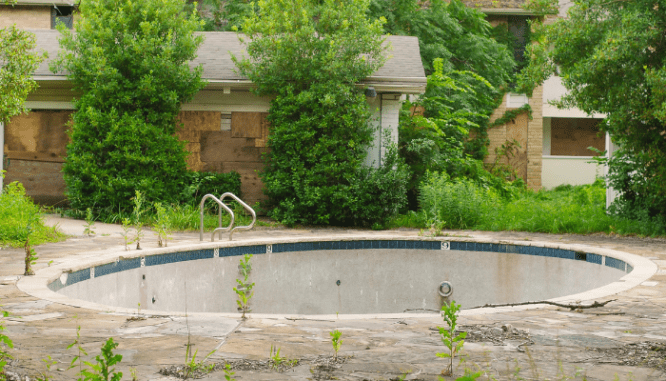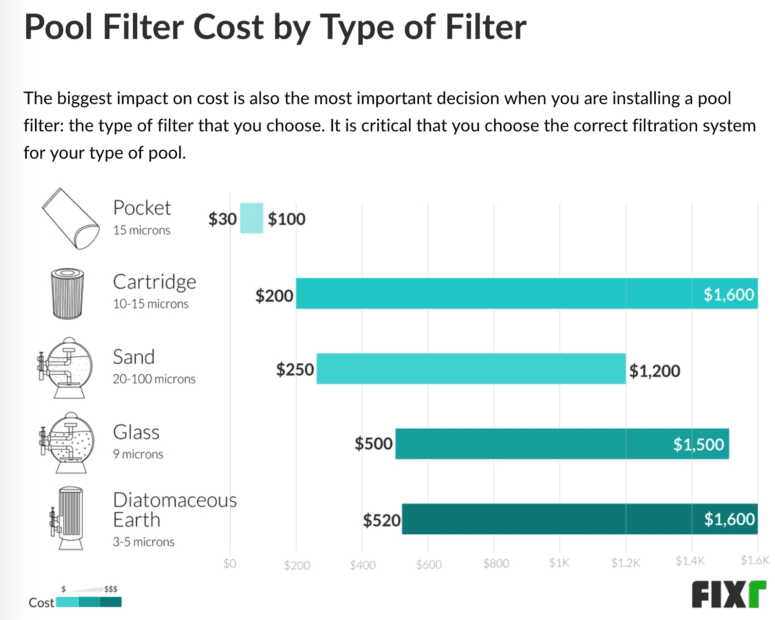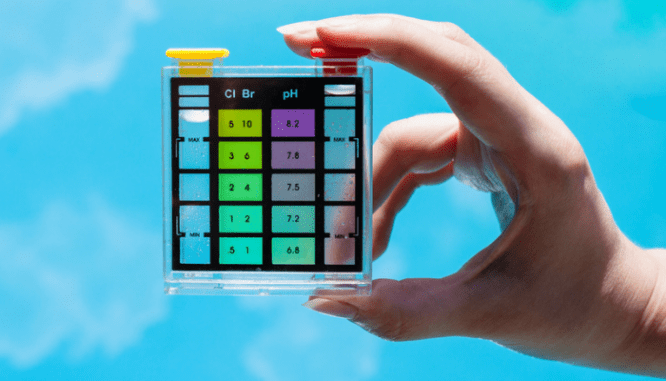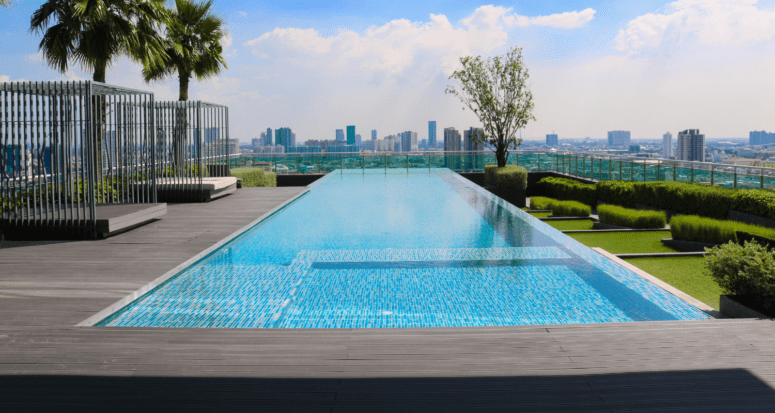How Much Does It Cost to Keep Your Swimming Pool Clean and Sparkling?
- Published on
- 5 min read
-
 Christine Bartsch Contributing AuthorClose
Christine Bartsch Contributing AuthorClose Christine Bartsch Contributing Author
Christine Bartsch Contributing AuthorFormer art and design instructor Christine Bartsch holds an MFA in creative writing from Spalding University. Launching her writing career in 2007, Christine has crafted interior design content for companies including USA Today and Houzz.
When the pandemic pool craze hit last summer, pool manufacturers and installers were stunned by the high demand. Pumps, heaters and building materials went out of stock for months on end. In 2020, the number of homeowners installing at-home swimming pools increased by 200% over 2019.
That demand has remained consistent, which has led to long waiting lists for pool installations that stretch well into 2021. The average price to install an in-ground pool is $42,480, according to HomeLight’s Fall 2020 real estate trends survey, but higher end versions can stretch into the $100,000-$150,000 range.
Given the high cost of entry into getting a pool in the first place, brand new pool owners-to-be often forget to consider the long-term costs of pool maintenance. While an in-ground pool is a backyard oasis promising relaxation, the care it requires is anything but restful.
“Most people are just excited about having a pool at home and they don’t think about how much it’ll cost in time and money to maintain it,” top-selling San Antonio, TX, real estate agent Carmen Bean. “Utilities are the biggest expense because you need to keep the pool pump running year round — and it works overtime in the summer months.”
Let’s take a look at the time, money, and effort required to maintain an in-ground pool, and how installing a pool can pay off in added home value when you’re ready to sell.

Pool maintenance cost overview
The cost of owning a pool will depend on factors like pool size, your sanitizing solution of choice, how often you heat the pool, and your climate severity. As a starting point, however, let’s review some broad estimates for ongoing pool maintenance costs reported by some of the major home improvement brands:
Cost estimate source: Home Advisor
National average monthly cost to maintain a pool: $230
Low and high end monthly cost to maintain a pool: $110-$349
Low and high end annual cost to maintain a pool: $1,200-$1,800
Average pool opening and closing costs: $450
Methodology: Cost data is based on actual project costs as reported by 6,603 HomeAdvisor members.
Cost estimate source: HomeGuide
National average monthly cost to maintain a pool: $112
Low and high end monthly cost to maintain a pool: $81 to $143
Low and high end annual cost to maintain a pool: $960 to $1,800
Average pool opening and closing costs: $300+
Methodology: HomeGuide annually tracks the cost estimates that their millions of users get from local companies, runs the stats to determine the national average, then shares those prices on its site.
Cost estimate source: Fixr
National average monthly cost to maintain a pool: $180
Low and high end monthly cost to maintain a pool: $90-$270
Low and high end annual cost to maintain a pool: $600-$1,850
Average pool opening and closing costs: $375-$500
Methodology: Fixr’s cost guides gather information from a great variety of sources, including specialized publications and websites, cost studies, U.S. associations, reports from the U.S. government, contractors and subcontractors, material suppliers, material price services, and other vendor websites.

Common pool maintenance costs:
If you want to keep your pool as sparking and refreshing as you’ll find at a swanky resort hotel, you’ll need to lay out a lot of cash for a variety of maintenance costs:
Pool cover
No one wants to swim amongst dirt, dead leaves, bugs, or worse. You’ll need a pool cover to keep that crud out, which will run you around $2,700 for a mesh cover to $3,700 for a solid pool cover.
Filters
Every in-ground pool comes with a filtration system installed to keep your water clean. There are a variety of filtration systems, and the cost to clean or replace the filters inside depend on the type of system installed. However, the national average cost to replace a pool filter amounts to $286 per filter, according to Porch.com.

Picking the right filtration system for you isn’t as simple as choosing the one with the cheapest filter costs. Keep in mind that less expensive filtration systems may cost you more over time.
Compare a sand with a cartridge filtration system. Between the two, sand filtration is cheaper to install when you first build your pool, and the sand inside only needs to be replaced every 5 to 10 years.
However, sand filtration systems require regular backwashing to keep it in operation, and that will increase your water costs over time. Cartridge filters can be rinsed clean of dirt and debris multiple times using much less water before they need to be replaced.
Cleaning
Even if you keep your cover on every second that you’re not using your pool, debris will find its way into your water. Skimming gets that junk out and you’ll need two types of skimmers to do the job.
The first skimmer is basically a net attached to a long pole used to manually skim your pool water for floating debris. These run between $10 for a basic skimmer to $25 for a deep, double net skimmer.
The second skimmer is installed as part of your pool system, and it works by pulling in the debris floating on your water surface and trapping it in a skimmer basket that needs to be regularly. If you don’t properly clean and maintain your installed skimmer, it’ll break and replacing it will cost you around $1,500 ($75-$150 for the part, and the rest to rip up and re-install your pool deck/patio).
Not all debris floats, that’s why you need an automatic pool cleaner attached to your pool’s filtration system to keep the bottom of your pool clean. Also known as pool vacuums, these units range from $80 for a lower end suction pool cleaner to $1,300 for a robotic one.
You’ll also need to brush down the sides of your pool to prevent algae, stains, and more. Pick up a standard pool brush for as little as $14 or a fancier one designed for maximum scrubbing power for $26.
Chemical balance
Keeping the pH level perfect in your pool is one of the most expensive pool maintenance chores in both time and money.
“Maintaining crystal clear water in a pool can be very tricky for homeowners who don’t have experience. Due to the extreme heat here in Texas, pools can turn green within hours. So it’s almost a daily chore to check your water and maintain the proper chemical balance,” advises Bean.
Pool usage, your city’s water quality, and even the weather can impact your pool’s chemical balance. Here’s a cost breakdown of the most common chemicals you may need to keep your pool’s water in balance:
from Fixr’s 2021 guide (costs reflect materials only):
Chlorine
A five-pound container of three-inch chlorinating tablets used as a pool sanitizer from Amazon costs $22.34. One tablet treats 10,000 gallons of water for up to a week.
Bromine
Bromine is the top alternative to chlorine and is known for being gentler on the skin. However, it does tend to be more expensive. A five-pound container of swimming pool brominating tablets costs $43.99 from Walmart, effectively double the cost of the chlorine tablets.
Algicide
This pool chemical helps to keep your water clear and sparkling by preventing and treating algae. A 128 oz. bottle of Algicide + Clarifier costs $10.98. Users report pouring in about a cup of the solution per week into a 30,000 gallon pool to remove pool cloudiness.
Water stabilizers
Also called a pool conditioner, chlorine stabilizer, or cyanuric acid, water stabilizers protect the chlorine in your pool from dissipating in the sun, effectively keeping your pool clean for a longer period. You can get a 25-pound back of stabilizer for $65.09. To figure out how much you’ll need (and at what frequency) you’’ll need to follow the instructions provided with the purchase and add the product slowly to avoid clogging the filter basket.
Pool shock
A pool shock is not a chemical, but it refers to the process by which you would add chlorine or non-chlorine chemicals to the pool to remove contaminants such as bacteria and algae. A pool shock is necessary in a few scenarios: 1) if you start to see algae growth, 2) if the “free chlorine” level hits zero, or 3) if chlorine level rises above 0.5 ppm, according to Fixr’s maintenance guide. You can test chemical levels with test strips or test kits. If your pool is in need of a pool shock, expect it to cost $25-$50, though it could cost more if you are first opening the pool for the spring.
Winterizing and reopening the pool
Unless you live in a warm southern state where pools are used year round, you’ll need to open your pool every spring and close (or winterize) it every fall.
Opening a pool consists of removing and storing the cover (if it’s permanent), cleaning and filling the pool (and repairing any damage), turning on the systems (pump, filtration, and heater), and balancing the water chemicals. Opening your inground pool will cost you between $90 and $325 — it all depends on how well you winterized it.
In warmer states, you need to address your chemical levels when cool weather hits to prevent pool-damaging bacteria and algae. In colder states where outdoor, in-ground pools are out of commission for months on end, you need to prevent damage from frozen water by lowering the pool water level, and draining and shutting off your heater and pump. On average, this process costs around $250 or up to $350 if your pool has a hot tub or waterfall.
Isolated repairs
The costs of owning a pool go beyond routine maintenance costs. If you account for repairs, pool ownership will cost you anywhere between $3,000 to $5,000 annually, according to statistics from HomeGuide and HomeAdvisor.
If the pool pump goes out, it’ll cost an average $700-$1,500 to replace it. You’ll also need to resurface your pool every few years (an estimated $6,500 expense). Over time, tiles crack, pool finishes flake off, and settling soil can cause cracks in your pool that, left unaddressed, will lead to leaks or structural issues.

Professional vs. DIY pool maintenance
Watch out: Keeping your pool water pristine is a demanding, arduous task that can eat away at your pleasure of owning a pool. Pool maintenance is a time-intensive process that must be done on the regular. It’s possible to DIY your pool maintenance, but it’s not recommended unless you’ve developed the required expertise.
If you aren’t vigilant about your maintenance the condition of your pool and the quality of your water will suffer. And if you let your pool go even a little, you’ll spend big bucks getting it back in shape — especially if you don’t know what you’re doing.
“Literally, if you skip just one day of pool maintenance your blue pool could turn green,” explains Bean. “Then you’ll spend hundreds, even a thousand dollars trying to get your pool blue again. Hiring someone who maintains pools for a living will take a lot of work off of your hands. And because they know what they’re doing, they can keep costs low.”
Along with knowledge, pool pros service a lot of pools, so they’re able to purchase their supplies and chemicals at a bulk rate that individual homeowners just can’t get.
How much you’ll pay for the services of a pool pro depends on how much you have them do and how often you have them come. Basic plans primarily cover maintaining the pH balance of your pool on a weekly basis, while deluxe plans tackle almost all of the maintenance, including skimming, brushing, and systems maintenance.
Some companies even offer combo plans that charge less for winter months when your pool is out of service, while others offer annual packages that include opening and closing the pool for around $1,750 to $2,300 in total.
Header Image Source: (Joe Ciciarelli / Unsplash)
